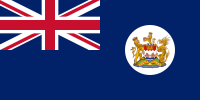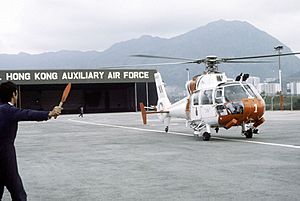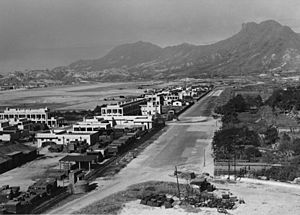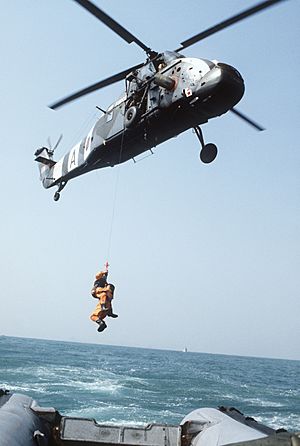British Forces Overseas Hong Kong facts for kids
Quick facts for kids British Forces Overseas Hong Kong |
|
|---|---|

Flag of Hong Kong (1959-1997)
|
|
| Active | 26 January 1841–30 June 1997 |
| Country | |
| Allegiance | |
| Branch | |
| Type | |
| Role | Territorial Defence |
| Size |
|
| Garrison/HQ | Garrison – All installments HQ – Flagstaff House (Residence of the CBF) |
| Anniversaries | Liberation Day |
| Equipment | |
| Engagements | |
| Commanders | |
| Commander-in-chief | Governor of Hong Kong |
| Commanding Officer | Commander British Forces in Hong Kong (CBF) |
| Inaugural holder of CBF | Major General George D'Aguilar |
| Final holder of CBF | Major General Bryan Dutton |
| Notable commanders |
|
| British Forces Overseas Hong Kong | |||||||||||
|---|---|---|---|---|---|---|---|---|---|---|---|
| Traditional Chinese | 駐港英軍 | ||||||||||
| Simplified Chinese | 驻港英军 | ||||||||||
|
|||||||||||
The British Forces Overseas Hong Kong were the military groups from the British Army, Royal Navy, and Royal Air Force stationed in British Hong Kong. The Governor of Hong Kong was the top commander of these forces. The Commander British Forces in Hong Kong (CBF) managed the daily tasks of the troops. Most of the British military left Hong Kong before it was returned to China in 1997. This article mainly talks about the British military presence in Hong Kong after the Second World War.
Contents
What They Did
Before and during the Second World War, the British military in Hong Kong included British Army soldiers and local people. These local people served as regular members in the Royal Navy's Hong Kong Squadron or the Hong Kong Military Service Corps. The Hong Kong Infantry Brigade was the main military group. When the Second World War began, more soldiers from the British Indian Army and Canadian Army joined them. A second group, the Kowloon Infantry Brigade, was created to help lead the larger force. However, the garrison was defeated by Japanese forces during the Battle of Hong Kong.
After the Second World War and the end of the Japanese occupation of Hong Kong, the British military returned. Because of the Chinese Civil War, the British Army sent the 40th Infantry Division to Hong Kong. This division later went to fight in the Korean War. Other British forces from Europe then took over the defense of Hong Kong. Local people and Gurkha soldiers from Nepal also joined these forces. The number of soldiers in Hong Kong changed over time during the Cold War, but it was usually around the size of one brigade.
The Royal Hong Kong Regiment was a local military unit. It was trained like a British Army Reserve unit. British Army soldiers helped lead this regiment. After the Second World War, most of its members were local Chinese citizens.
Their Responsibilities
Before July 1, 1997, the British government promised to protect Hong Kong from dangers both inside and outside the territory. Forces from other Commonwealth countries also came to Hong Kong before the Second World War. The biggest challenge was in 1941, when Japanese forces attacked Hong Kong. This led to a 44-month period of Japanese control.
Keeping public order was the job of the Hong Kong Government, especially the Royal Hong Kong Police. The British Forces in Hong Kong would help if asked. During the 1967 Hong Kong disturbances, the British military helped the police calm the situation. Until 1995, British forces were responsible for patrolling the border between Hong Kong and China. They helped stop people from crossing the border without permission. This job was later given to the Hong Kong Police before the 1997 handover.
The Royal Navy also helped the Royal Hong Kong Police. They worked together to stop smuggling in Hong Kong waters, especially from the mid-1980s to the mid-1990s.
All parts of the British Forces in Hong Kong also helped with search and rescue missions. They provided aid in emergencies and civil defense situations.
The Government Flying Service (GFS) now handles search and rescue operations, air ambulance services, and other air services for the Hong Kong Government. The GFS took over some duties from the Royal Air Force and the Army Air Corps. The Hong Kong Police Force also has special units for counter-terrorism and marine policing. These units have been well-equipped since before 1997.
The Fire Service Department also took over some diving rescue duties from the British Forces.
The Royal Hong Kong Regiment (The Volunteers) was disbanded in 1995, before the 1997 handover. It was funded by the Hong Kong Government but was under the command of the Commander British Forces in Hong Kong.
How They Were Organized
The Governor of Hong Kong, who represented the British Monarch, was the top commander of the British Forces in Hong Kong. The Governor received advice from the Commander British Forces in Hong Kong (CBF) on all military matters. In the 1980s and 1990s, the CBF was usually a high-ranking officer from the British Army.
Over the years, many different British Army units served in Hong Kong. After the war, British Army units were sent to Hong Kong for three-year periods. Most of the infantry battalions were Gurkhas, who were based in Hong Kong permanently after India became independent.
British Army Groups
Major groups of the British Army in Hong Kong included:
During World War II
- Headquarters, China Command (1939): This group managed British military interests in Hong Kong, Shanghai, and Tientsin.
- Hong Kong Infantry Brigade: This was the main British military group in Hong Kong before and during the Second World War.
- Kowloon Infantry Brigade: This group was formed in 1941 when more soldiers arrived.
- C Force: Canadian Army soldiers who helped under British command during the Battle of Hong Kong in 1941.
During the Cold War
- 40th Division (reformed in 1949, sent to Korea in 1950)
- 51st Infantry Brigade (formed around 1950, disbanded 1976)
- 48th Gurkha Infantry Brigade (1957–1976; later renamed Gurkha Field Force)
British Army Units
Many different units served in Hong Kong. Here are some examples:
Armored Units
These units used tanks and armored vehicles.
- 1st Royal Tank Regiment (1957–1960)
- 7th Hussars (1954–1957)
Infantry Units
These units were made up of foot soldiers.
- 1st Battalion, King's Own Scottish Borderers (1949–1951, and again in 1965)
- 1st Battalion, South Wales Borderers (1930–1934; 1963–1966)
- 1st Battalion, Middlesex Regiment (1937–1941; 1949–1950; 1951–1952)
- 1st Battalion, Royal Green Jackets (1977–1980)
- 1st Battalion, Black Watch (Royal Highland Regiment) (1993–1994, 1997)
Gurkha Units
Gurkha soldiers from Nepal were a very important part of the British forces in Hong Kong.
- 1st Battalion, 2nd King Edward VII's Own Gurkha Rifles (served many times between 1971 and 1992)
- 1st Battalion, 6th Queen Elizabeth's Own Gurkha Rifles (served many times between 1956 and 1993)
- 1st Battalion, The Royal Gurkha Rifles (1994–1996)
Artillery Units
These units operated large guns.
- Hong Kong and Singapore Royal Artillery (1847 to 1940s)
- 3rd Regiment Royal Horse Artillery (1973–1975)
- 25th Field Regiment, RA (1947–1955; 1969–1971)
Engineer Units
These units built and maintained military structures.
- Royal Engineers and Queen's Gurkha Engineers
- 22nd Fortress Company, Royal Engineers (around 1939)
- Queen's Gurkha Engineers (formed in Hong Kong in 1952)
Signal Units
These units handled military communications.
- Royal Signals and Queen's Gurkha Signals
- 27th Signal Regiment, Royal Signals (arrived in Hong Kong in 1949)
- Queen's Gurkha Signals (had squadrons like 247 and 248)
Support Units
Many other units provided support services, such as medical care, logistics, and transport.
- Army Air Corps: Flew helicopters for support.
- Hong Kong Military Service Corps: A local unit with Chinese members.
- Royal Army Medical Corps: Provided medical care, including at the British Military Hospital, Hong Kong.
- Royal Corps of Transport: Handled transportation of supplies and personnel.
- Royal Hong Kong Regiment: A local volunteer force.
- Royal Military Police: Maintained order and security.
Military Bases and Buildings
The British Army had many bases and buildings in Hong Kong. Some of these are now used for other purposes.
- Flagstaff House: The former home of the Commander British Forces. Now a museum.
- Gun Club Hill Barracks: Now used by the Chinese military.
- Lyemun Barracks: Used for coastal defense, now a museum and holiday village.
- Victoria Barracks: A large area that now includes parks, hotels, and art centers.
- Sek Kong Barracks: A major base for Gurkha units.
- Stanley Fort: A historic fort that also served as a prison.
The Royal Navy and Royal Marines were in Hong Kong from the very beginning of its time as a British colony. Their main base was HMS Tamar on Hong Kong Island.
Many Royal Navy ships visited or were based in Hong Kong over the years.
- HMS Sulphur (1841)
- HMS Tamar (around 1897)
- HMS Amethyst (1948)
- HMS Invincible (1992)
- HMY Britannia (The Royal Yacht, visited in 1986, 1990, and 1997)
The Royal Navy also had several facilities in Hong Kong.
- Stonecutters Island: Used for radio interception and as a base for transport units.
- Prince of Wales Building: Now part of the Chinese military's barracks.
- Royal Navy Dockyards: Places where ships were repaired and maintained.
- Royal Naval Hospital, Wan Chai: A hospital for naval personnel, now replaced by Ruttonjee Hospital.
Royal Air Force

The Royal Air Force (RAF) was the smallest part of the British Forces. They were stationed at Kai Tak Airport and Sek Kong Airfield.
No. 28 (AC) Squadron moved to RAF Sek Kong in the late 1970s. They flew up to eight Westland Wessex HC Mk 2 helicopters. Their jobs included supporting the police, helping other British Forces, and conducting search and rescue missions. RAF personnel returned to Kai Tak before the 1997 handover.
The Hong Kong Government also had its own "air force," the Royal Hong Kong Auxiliary Air Force. RAF personnel helped train and support this local air force. It was later handed over to the Government Flying Service (GFS).
RAF Units
Some RAF units that served in Hong Kong included:
- No. 28 Squadron RAF (served many times between 1949 and 1997)
- No. 81 Squadron RAF (1947–1958)
- No. 209 Squadron RAF (Maritime Patrol) (1946–1955)
RAF Stations
RAF stations in Hong Kong included:
- RAF Sha Tin: Later demolished to build a new town.
- RAF Sek Kong: Also used as a Vietnamese detention center in the 1980s.
- RAF Kai Tak: Later became Kai Tak International Airport.
Search and rescue operations by the RAF and Royal Navy were later taken over by the Government Flying Service (GFS).
Other Facilities
- British Military Hospital, Hong Kong: Provided healthcare for military personnel.
- British Forces Broadcasting Service: Provided radio and TV for the forces.
- Navy, Army and Air Force Institutes (NAAFI): Shops and services for military families.
- China Fleet Club: A special club for Royal Navy sailors. It moved to a new building in Hong Kong in 1985 and then to the UK in 1992.
See also
- People's Liberation Army Hong Kong Garrison
- Military of Macau under Portuguese rule
- Hong Kong Defence Force (Imperial Japanese Army)



